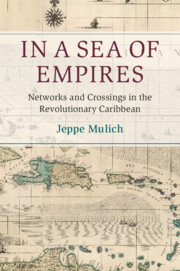Book contents
- In a Sea of Empires
- Cambridge Oceanic Histories
- In a Sea of Empires
- Copyright page
- Dedication
- Contents
- Figures
- Tables
- Acknowledgments
- 1 Introduction
- 2 Free Ports and Black Markets
- 3 Imperial Warfare, Colonial Violence
- 4 Prize Courts and Privateers
- 5 Slave Laws and Free Communities
- 6 Abolition and the Illegal Slave Trade
- Conclusion
- Bibliography
- Index
6 - Abolition and the Illegal Slave Trade
Published online by Cambridge University Press: 24 June 2020
- In a Sea of Empires
- Cambridge Oceanic Histories
- In a Sea of Empires
- Copyright page
- Dedication
- Contents
- Figures
- Tables
- Acknowledgments
- 1 Introduction
- 2 Free Ports and Black Markets
- 3 Imperial Warfare, Colonial Violence
- 4 Prize Courts and Privateers
- 5 Slave Laws and Free Communities
- 6 Abolition and the Illegal Slave Trade
- Conclusion
- Bibliography
- Index
Summary
Chapter 6 begins with an analysis of the inter-imperial political context within which the abolition of the slave trade was enacted, focusing in particular on the Danish and British edicts outlawing the trade in 1803 and 1807, respectively. It continues with an examination of the practical implementation of the ban and ends with a more detailed treatment of the continuation of the illicit intercolonial trade as carried out within the microregion of the Leeward Islands. The history of the abolition of the slave trade has most often been told from the perspective of imperial legislators and advocates of abolition. When the implementation of the abolition has been treated with serious effort, it has typically been done either through a top-down analysis of diplomacy and international politics or via studies of the places most notably evading the abolition. Employing a microregional perspective and using the Leeward Islands as the historical case reveals a different side of the story of abolition. This analysis largely confirms the hierarchical dimension of the slave trade abolition in an inter-imperial context, but it also illustrates the vast gaps between imperial policy and colonial practice by showcasing the myriad ways in which local actors and networks circumvented official decrees and continued trading in slaves.
- Type
- Chapter
- Information
- In a Sea of EmpiresNetworks and Crossings in the Revolutionary Caribbean, pp. 134 - 156Publisher: Cambridge University PressPrint publication year: 2020

